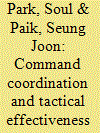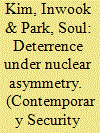| Srl | Item |
| 1 |
ID:
158978


|
|
|
|
|
| Summary/Abstract |
This article analyzes the causes of combat effectiveness of the South Korean security forces through the course of its various counter-insurgency (COIN) operations from 1948 to 1953. We argue that improvements in two interrelated aspects ultimately resulted in higher operational and tactical level performance: unified operational command structure and the subsequent improvements in tactical efficiency under the guidance of the US advisory mission. Through an in-depth case study on how a nascent army improved its capacity in combating homegrown insurgencies, we demonstrate how the actual conduct of operations itself remains just as significant in the assessment of overall COIN outcomes.
|
|
|
|
|
|
|
|
|
|
|
|
|
|
|
|
| 2 |
ID:
166610


|
|
|
|
|
| Summary/Abstract |
The 2016 decision to deploy Terminal High Altitude Area Defense (THAAD) to South Korea has generated multitude of intensely politicized issues and has proved highly controversial. This has made it challenging to alleviate, let alone clarify, points of analytical and policy tensions. We instead disaggregate and revisit two fundamental questions. One is whether THAAD could really defend South Korea from North Korean missiles. We challenge the conventional “qualified optimism” by giving analytical primacy to three countermeasures available to defeat THAAD–use of decoys, tumbling and spiral motion, and outnumbering. These countermeasures are relatively inexpensive to create but exceedingly difficult to offset. Second, we assess the optimal way to ensure South Korean national security against North Korean missiles. By examining the balance of capability and issues of credibility/commitment, we show that the U.S. extended deterrence by punishment remains plentiful and sufficiently credible even without enhancing the current defense capability.
|
|
|
|
|
|
|
|
|
|
|
|
|
|
|
|
| 3 |
ID:
188253


|
|
|
|
|
| Summary/Abstract |
This paper analyses the dynamics of violence during civilian displacement operations. Specifically, we argue that the integration of security forces – solid command structure, monitoring of troops, and the quality of personnel – influences not only the military performance but also the level of civilian costs. That is, a highly integrated army can commit soldiers to displacement operations while minimising violence. When conducted by a partially integrated army, however, displacement operations are at risk of mass killing, pushing soldiers to remove civilians without sophisticated control. Our qualitative analysis of three major counter-guerrilla operations in South Korea provides support for our thesis.
|
|
|
|
|
|
|
|
|
|
|
|
|
|
|
|
| 4 |
ID:
171789


|
|
|
|
|
| Summary/Abstract |
The emergence of new nuclear aspirants has posed a great threat to the post-Cold War global non-proliferation regime. These states have adopted a nuclear hedging strategy that has been deemed both strategically risky and politically difficult to maintain. Yet, hedging has not automatically resulted in nuclearisation. We analyse the conditions under which a nuclear hedger shifts its nuclear policy towards one of restraint. Drawing insights from prospect theory, we argue that a nuclear policy shift occurs when a nuclear hedger gains an asymmetric leverage vis-à-vis its adversary. Specifically, a hedging strategy that is based on loss aversion will only be abandoned when a shift in the nuclear aspirant's reference point occurs during negotiations. To test our theoretical arguments, we conduct an in-depth case study of North Korea's nuclear policies throughout the 1990s and 2000s. The empirical study of the changes in North Korea's negotiating stance during the Agreed Framework negotiations and the Six-Party Talks supports our asymmetric leverage thesis. We conclude with broad policy implications for the non-proliferation regime.
|
|
|
|
|
|
|
|
|
|
|
|
|
|
|
|
| 5 |
ID:
180871


|
|
|
| 6 |
ID:
096702


|
|
|
|
|
| Publication |
2010.
|
| Summary/Abstract |
This paper systematically analyzes the causes of the escalation of violence during the initial stages of the Jeju Island Rebellion and the failure of South Korean counterinsurgency operations. It is argued that four interrelated factors provided the conditions for armed insurgency in the small island of Jeju: inter-agency tension between the Korean National Police (KNP) and the Korean Constabulary; the mainlanders' misinterpretation of the insurgency; the effect of systematic police brutality; and the role of youth groups. Consequently, two counterinsurgency lessons will be drawn from this study: that inter-agency cooperation and coordination at the tactical level between security branches and the incorporation of local population at the micro-level is essential in conducting efficient and effective counterinsurgency operations.
|
|
|
|
|
|
|
|
|
|
|
|
|
|
|
|